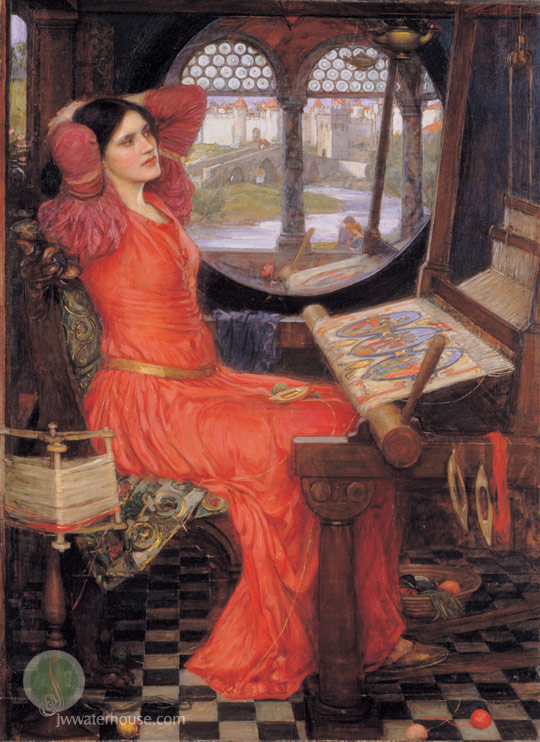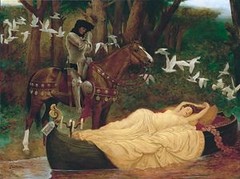The Portrayal of the Cloistered Victorian Woman
Shabnam Yusufzai and Sue Chun
1374
The cloistered woman in Tennyson’s “The Lady of Shalott” lives in a world of shadows. The Lady’s only glimpse of the outside world is through the magic mirror, which is ironically the symbol of her separation.@Joseph Chadwick. "A Blessing and a Curse: The Poetics of Privacy in Tennyson's "The Lady of Shalott". Critical Essays on Alfred Lord Tennyson (1993): 83-99. Web. 24 Mar. 2011. The mirror shows only the shadows of others, rather than the Lady’s own reflection. This shows the Lady’s dependency on the outside world and her eagerness to be apart of the social realm but must abide by her cloistered situation. The omission of the Lady’s own image in the mirror represents her non-existence status to the outside world. She sees everything in the mirror that she is not exposed to but wishes to embody and experience: village-churls, market girls, damsels, the abbot, the shepherd, the page, the knights, the funeral party, and lastly the newlywed lovers. Furthermore, it is the very sight of the “two young lovers lately wed” that prompts the Lady to say, “I am half sick of shadows”. As a result, it is the institution of marriage that provokes the Lady’s desire to find martial love and to live in a life outside of shadows. The Lady crosses gender lines by leaving her interior world in order to enter the exterior world of men. Her actions seem to be progressive but because the Lady’s motivation derives from her quest to find marriage. Tennyson is not challenging the status quo but rather reinforcing patriarchal norms. He is also acknowledging the “Women Question” which was a predominant topic in the 19th century, particularly during the time “The Lady of Shalott” was written.@Carl Plasa. "Cracked from Side to Side": Sexual Politics in "The Lady of Shalott". Victorian Poetry Vol.30 (1992):247-263. West Virginia Press. Web. 24 Mar. 2011. <http://www.jstor.org/stable/40002467>. For example, there was a lot of political debate during this time in England and Tennyson became very much involved with the first Reform Bill of 1832. It can be argued that during this political time involving women’s rights and their role in society, Tennyson wrote “The Lady of Shalott” in response to the poltical events surrounding his society. However, it seems as though Tennyson highlights the anxieties most unmarried Victorian women felt by creating a sense of insecurity within the Lady. Furthermore, the second half of the poem clearly shows Tennyson’s stance on the roles of Victorian women where he punishes his female protagonist by virtue of death.

|

|
Tennyson’s “The Lady of Shalott” can also be seen as a didactic poem that has a clear message directed towards Victorian women. It is not until the Lady’s gaze aligns with the outside world of Camelot that ignites the curse. As a result, death is the only suitable punishment for the Lady who dares to look at the public space that is occupied for men. The Lady’s transition from the private/feminine to public/masculine space is seen as a defiant act, and thus serves a didactic message, cautioning Victorian women not to step out of their sphere. Ultimately, “The Lady of Shalott’s” fate is sealed when she reaches land and therefore her movement to the social world is not complete but she is only present in death.@Meg Mariotti. "The Lady of Shalott: Pre-Raphaelite Attitude Toward Women in Society." 2004. The Victorian Web. 24 Mar. 2011.
For ere she reached upon the tide
The first house by the water-side,
Singing in her song she died,
The Lady of Shalott. (II.150-153)
For ere she reached upon the tide
The first house by the water-side,
Singing in her song she died,
The Lady of Shalott. (II.150-153)


